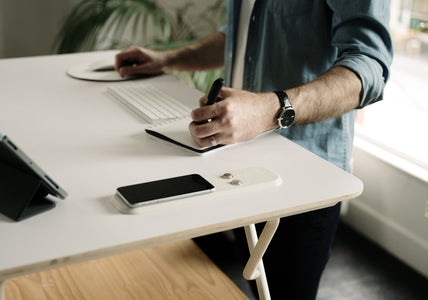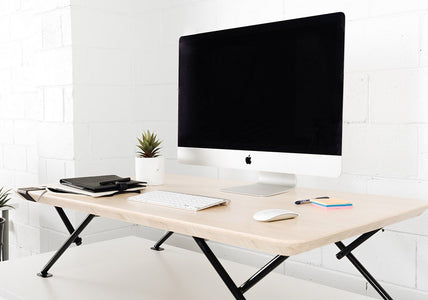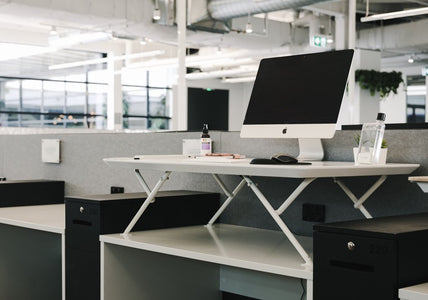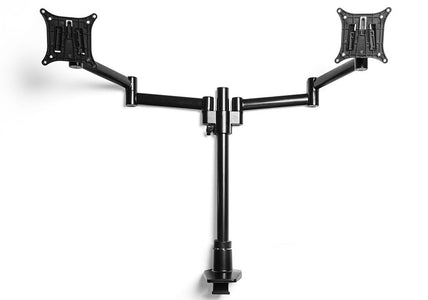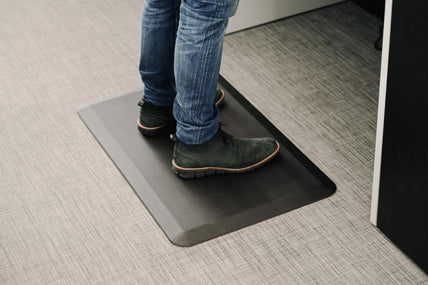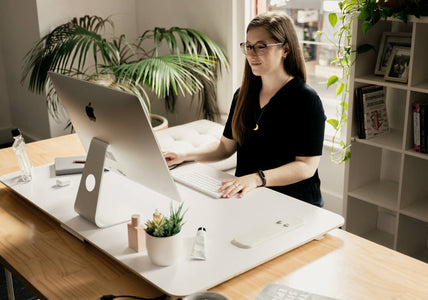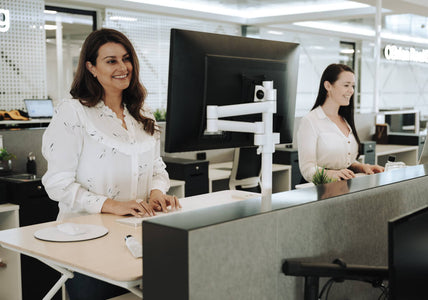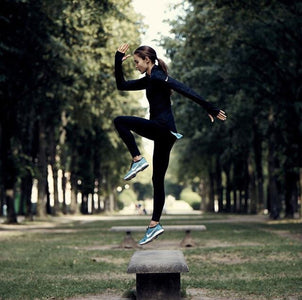What it was like to embark on a 3 year journey to design the MOVI Desk
By Daniel Angelini on June 18, 2019How did we go about envisioning the perfect standing desk solution?
MOVI is the name of my standing desk product. My design intention is for it to be the most ergonomic and spacious standing desk top platform in the world.
There are some major problems with most height adjustable, sit-stand desk top platforms available (these are the products that go onto an existing desk).
The common issues are:
» They’re not ergonomic: most products only allow 35cm (13.7”) of height elevation meaning that users taller than 178cm (5’ 10”) won’t have an ergonomic setup.
» Potential back strain: Moving from sitting to standing can be a hazard because the lifting levers are quite far from you, requiring you to lean and reach forward. This can lead to shoulder, neck and back strains.
» Restrictive workspace: most platforms have small keyboard trays as the primary working area, which can be very restrictive and limiting.
» Bulky design: many products are not aesthetically pleasing or refined, and take up a lot of space in the office, making them look and feel out of place.

I wanted my product to overcome these issues and also be aesthetic, elegant,
practical, and spacious. I knew it needed to be simple, solid, of high quality,
truly ergonomic, suitable for taller and shorter users, adaptive for people of all sizes, moveable, adaptable to any monitor size, reliable, and affordable.
And so the sketching began. Literally hundreds of shapes, sizes and configurations, exploring how this perfect standing desk could be designed.
I began sketching a whole range of concepts, with three main design influences in mind, which I used for inspiration every day. These are.
Everything by Apple - obviously, their sleekness needs no explanation.
Element by Tokujin Yoshioka - a collection of designer tables that defy gravity.
4-Dots Table by Nomess Copenhagen - refined Scandinavian design at it’s best.
HOW I CAME UP WITH MY DESIGN
After a lot of research, product testing and surveying of users, I compiled a list of requirements for the
‘perfect’ design:
Ergonomic: infinitely adjustable platform to allow a truly ergonomic setup,
Spacious: a primary working area that is unencumbered by anything unnecessary,
Desktop Add On:an affordable platform easily retrofitted to existing office desk,
Extra Low Profile:a slim construction to sit seamlessly on an existing desk,
Refined Designed:an aesthetic that will enhance office spaces and entice use,
Simple Adjustability: making it quick and seamless to move between sitting and standing regularly,
Sustainable:use sustainably sourced materials that can be easily regenerated.

With this and my design inspirations in mind, I eventually worked out the best structure. The design came from observing many different structures, in particular, The London Bridge. When the drawbridge is retracted, from a certain angle it looks like the top of the bridge is touching the raised road ramps. This helped me generate the idea of creating a large workspace platform elevated by legs that can collapse in toward the centre of the platform with a large workspace area and additional monitor platform on top.
There are three major advantages of this design approach over other products out there:
» The workspace area could be a large rectangular platform, without any obstructions or interferences, creating an open workspace,
» The maximum extendable height of the desk could be significant, as the legs allow for 45cm (~18”) of lift, enabling the desk to suit very tall users (and equally as able to cater to short users) ergonomically,
» Office space wouldn’t be wasted as the product would raise vertically directly, making it convenient to retrofit in office spaces of all sizes.
I then needed to work out the mechanical solution for it. Every imaginable combination was considered. It took over 18 months of designing, testing, prototyping and virtual simulations to finally determine the
most suitable solution for raising and lowering the desk. 10 engineers were involved at different stages throughout this process.
First I considered springs, but these didn’t work. Since the product raises vertically there’s the potential to launch the desk towards the ceiling if it’s not counterweighted with equipment. Next, pneumatic cylinders (often seen on self-closing doors), but these didn’t work as they’re unable to lift when the platform is in the flat position. Then a manually wound mechanism was considered, but it would take much too long to adjust your position. Ultimately, an electric motor was considered. It was significantly more complex to engineer, but was by far the most convenient for usability, and I didn’t want to compromise on the user experience.
Finally…
Victory!
